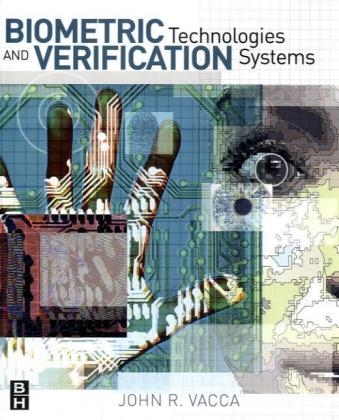
Biometric Technologies and Verification Systems
Butterworth-Heinemann Ltd (Verlag)
978-0-7506-7967-1 (ISBN)
Biometric Technologies and Verification Systems is organized into nine parts composed of 30 chapters, including an extensive glossary of biometric terms and acronyms. It discusses the current state-of-the-art in biometric verification/authentication, identification and system design principles. It also provides a step-by-step discussion of how biometrics works; how biometric data in human beings can be collected and analyzed in a number of ways; how biometrics are currently being used as a method of personal identification in which people are recognized by their own unique corporal or behavioral characteristics; and how to create detailed menus for designing a biometric verification system. Only biometrics verification/authentication is based on the identification of an intrinsic part of a human being. Tokens, such as smart cards, magnetic stripe cards, and physical keys can be lost, stolen, or duplicated. Passwords can be forgotten, shared, or unintentionally observed by a third party. Forgotten passwords and lost "smart cards" are a nuisance for users and an expensive time-waster for system administrators. Biometric security solutions offer some unique advantages for identifying and verifying/ authenticating human beings over more traditional security methods. This book will serve to identify the various security applications biometrics can play a highly secure and specific role in.
John Vacca is an independent information technology consultant and researcher, professional writer, editor, reviewer, and author based in Pomeroy, Ohio, USA. Since 1982, John has authored, edited, and published more than 85 books, including Smart Cities Policies and Financing: Approaches and Solutions, Elsevier; Cloud Computing Security: Foundations and Challenges, Taylor and Francis/CRC Press; Solving Urban Infrastructure Problems Using Smart City Technologies: Handbook on Planning, Design, Development, and Regulation, Elsevier; Online Terrorist Propaganda, Recruitment, and Radicalization, Taylor and Francis/CRC Press; Nanoscale Networking and Communications Handbook, Taylor and Francis/CRC Press; Handbook of Sensor Networking: Advanced Technologies and Applications, Taylor and Francis/CRC Press; Network and System Security 2/e, Elsevier/Syngress; Cyber Security and IT Infrastructure Protection, Elsevier/Syngress; and Managing Information Security 2/e, Elsevier/Syngress; among many others. John was a Configuration Management Specialist, Computer Specialist, and the Computer Security Official (CSO) for NASA’s space station program (Freedom) and the International Space Station Program from 1988 until his retirement from NASA in 1995. John has also been a security consultant for major motion pictures, including AntiTrust, Collateral, and Identity Theft: The Michelle Brown Story. He received his M.Sc. from Kansas State University and an MBA from Emporia State University and served in the United States Air Force from 1967-1971.
Part 1: Overview Of Biometrics Technology And Verification SystemsCHAPTER 1: What Is Biometrics?CHAPTER 2: Types Of Biometrics Technology And Verification SystemsCHAPTER 3: Biometrics Technology And Verification Systems StandardsPart 2: How Biometrics Eye Analysis Technology WorksCHAPTER 4: How Iris Pattern Recognition WorksCHAPTER 5: How Retina Pattern Recognition WorksPart 3: How Biometrics Facial Recognition Technology WorksCHAPTER 6: How Video Face Recognition WorksCHAPTER 7: How Facial Thermal Imaging In The Infrared Spectrum WorksPart 4: How Biometrics Finger Scanning Analysis Technology WorksCHAPTER 8: How Finger Image Capture WorksCHAPTER 9: How Fingerscanning Verification And Recognition WorksPart 5: How Biometrics Geometry Analysis Technology WorksCHAPTER 10: How Hand Geometry Image Technology WorksCHAPTER 11: How Finger Geometry Technology WorksPart 6: How Biometrics Verification Technology WorksCHAPTER 12: How Dynamic Signature Verification Technology WorksCHAPTER 13: How Voice Recognition Technology WorksCHAPTER 14: How Keystroke Dynamics Technology WorksCHAPTER 15: How Palm Print Pattern Recognition Technology WorksCHAPTER 16: How Vein Pattern Analysis Recognition Technology WorksCHAPTER 17: How Ear Shape Analysis Technology Works CHAPTER 18: How Body Odor And/Or Scent Analysis And Other Advanced Technology WorksCHAPTER 19: How DNA Measurement Technology WorksPart 7: How Privacy Enhanced Biometrics Based Verification/Authentication WorksCHAPTER 20: How Fingerprint Verification/Authentication Technology WorksCHAPTER 21: Vulnerable Points Of A Biometric Verification SystemCHAPTER 22: How Brute Force Attacks WorkCHAPTER 23: How Data Hiding Technology WorksCHAPTER 24: Image-Based Challenges/Response MethodsCHAPTER 25: How Cancelable Biometrics WorkPart 8: Large-Scale Implementation/Deployment Of Biometrics Technologies And Verification SystemsCHAPTER 26: Specialized Biometrics Enterprise DeploymentCHAPTER 27: How to Implement Biometrics Technology And Verification SystemsPart 9: Biometrics Solutions And Future DirectionsCHAPTER 28: How Mapping The Body Technology WorksCHAPTER 29: Selecting Biometric SolutionsCHAPTER 30: Biometric Benefits
| Erscheint lt. Verlag | 23.4.2007 |
|---|---|
| Verlagsort | Oxford |
| Sprache | englisch |
| Maße | 191 x 235 mm |
| Gewicht | 1090 g |
| Themenwelt | Mathematik / Informatik ► Informatik ► Betriebssysteme / Server |
| Technik | |
| ISBN-10 | 0-7506-7967-0 / 0750679670 |
| ISBN-13 | 978-0-7506-7967-1 / 9780750679671 |
| Zustand | Neuware |
| Haben Sie eine Frage zum Produkt? |
aus dem Bereich


